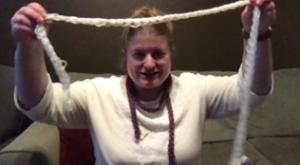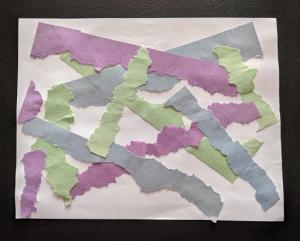Categories
Watch this project at: https://youtu.be/xJ0lqs_BoLg?list=PLMEg2Dd0dSFctLfDQxsL5SmuE8zkwQFmu
Supplies:
- Yarn
- Your fingers
Directions:
- Take the end of the yarn and loop it around the pointer finger of your non-dominant hand (if you are right-handed, tie the knot around the pointer finger of your left hand; if you are left-handed, tie the knot around the pointer finger of your right hand). Optional: Tie a knot to keep the yarn loop in place.
- On the same hand with the knot, weave the yarn around your fingers. Go behind your middle finger, in front of your ring finger, around your pinky, behind your ring finger, in front of your middle finger, and behind your pointer finger.
- Repeat the weaving pattern so that you have two loops of yarn around each finger.
- You want the loops of yarn around your fingers to be loose enough to slide off your fingers but tight enough that they don’t fall off accidentally. Use your thumb to hold the loose end of the yarn tight.
- Take the bottom loop of yarn on your pinky finger and pull it over the top loop of yarn and off your finger. You should have only one loop of yarn on your pinky finger.
- Repeat for each of your fingers. Pull the bottom loop of yarn over the top loop and off your fingers.
- Push the remaining loop of yarn on each finger down toward the base of your fingers. They are now the bottom loops of yarn.
- Repeat steps 3-8 until you’re ready to be done with your finger knitting.
- To cast off (or end your project), cut the yarn so you have about three inches left. Thread the end of the yarn through the loop of yarn on each finger, starting with the pointer finger and ending with the pinky.
- Pull each loop of yarn off your fingers and pull the loose end tight. Tie the end of the yarn in a knot around one of the loops of yarn to fasten. Cut off the extra “tail” of yarn.
- If you would like to take a break while working on your knitting, use a long, rounded object (a pen, pencil, chop stick, or knitting needle). Slide the loops of yarn off your fingers and onto object and put in a safe place until you’re ready to start finger knitting again.
To restart your project, slide the loops of yarn back onto your fingers. Remember that the loose end of thread will be on your pointer finger and that the knitting will lay against the back of your hand. Repeat steps 3-8 to continue knitting.
Watch this homeschool project at: https://youtu.be/Hes9P7sXTD4?list=PLMEg2Dd0dSFcQoPQnZvsy70uOGw-GdBLE
Supplies:
- 2 half sheets of cardstock; 4 craft sticks
- 1 gable roof template- see below
- 1 hip roof template sheet of aluminum foil
- 1 “plate of fortune cookies” (photo on cardstock)
- Glue
- Scotch tape
- Packing tape
- Shallow jar lid
- Sheet for foundation (cardboard, foamboard, or cardstock)
- Flat bake sheet (optional)
- Leaf blower, electric fan, or hair dryer
- squirt bottle or watering can with sprinkle spout
- Baking rack (or similar object)
- Plastic dishpan tub (optional)
Directions:
See detailed directions and templates in the pdf links below!
Photo by Jo Kassis from Pexels
Have fun tearing or cutting strips of paper and creating a collage. A collage is a work of art made by gluing pieces of different materials or different size materials to a flat surface.
For this project, your child will glue strips of construction paper to the white paper to create a unique work of art. You'll need a piece of white paper and a few colors of construction paper plus glue.
Directions:
- To begin, have your child use child-safe scissors to cut the construction paper into strips or different size pieces. Your child can tear the paper if you do not have child-safe scissors.
- Let your child glue or tape the construction paper onto the white paper however they want to create their collage.
Early Literacy Tip:
This project helps young children develop the fine motor skills they need to hold pencils and crayons. Having strong motor skills will help children as they begin the process of learning how to write. How can cutting or tearing paper develop this skill? As children tear or cut the paper, they are building the small muscles in their palm and hand. They are also enhancing their eye-hand coordination. They must be able to see what they are tearing or cutting while moving their hand. Learning how to use scissors plays an important role in developing fine motor skills. Here are some tips for teaching your child how to use child-safe scissors:
- To help your child remember how to hold a pair of scissors, draw a smiley face on the thumbnail of your child’s cutting hand. The smiley face reminds them to keep their thumb up when cutting.
- Cutting paper can be tricky; practice cutting playdough first.
- Cardstock is easier to cut than paper. Let your child cut old greeting cards or old playing cards.
- Provide activities that use tools such as tongs, hole punches, tweezers, eyedroppers, and clothespins to strengthen fine motor skills necessary for cutting.
- It might sound easy, but teaching young children how to cut with scissors is a very complex task. Try using this rhyme to help your child remember how to hold and use scissors properly:
Two fingers on the bottom
and the thumb on top.
Open the mouth and go
chop, chop, chop.





